Wildflowers of Mount Rainer
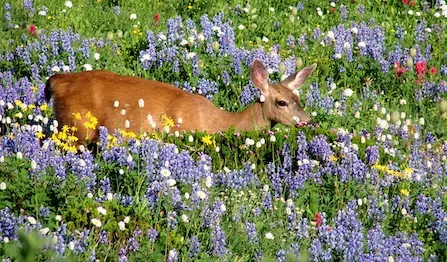
There are hundreds of species of wildflowers found in Mount Rainier National Park, far more than can be represented here. However, this identification guide is meant to help you familiarize yourself with some of the most common and interesting wildflowers you may see during your visit to the park. For identification of flowers in the field, you can download the Mount Rainier Wildflower site bulletin, ask a ranger, or purchase a variety of wildflower identification guidebooks available in the park visitor centers and gift shops. For updates on which wildflowers are currently blooming during the summer, visit the Discover Wildflowers webpage.
For convenience, this guide divides wildflower species into two main categories, forest and subalpine, based on the environment the flower species commonly grows in. The categories are further subdivided by flower color to aid in easy identification.
Though some overlap occurs, forest and subalpine areas of the park host distinct groups of wildflower species:
Dense old growth forest creates cool, shady conditions suitable to wildflower species different from the ones found in the sunnier subalpine meadows. Dense forest covers the low-to-mid elevations of the park from approximately 2,000 to 4,500 feet (610-1372 meters).
Subalpine meadows or "parkland" wreath the higher elevations of Mount Rainier, from about 4,500 to 6,500 feet (1372-1981 meters). This region is sometimes called subalpine parkland because at those elevations trees start thin out and grow in patches interspersed among meadow instead of continuous forest. Eventually trees disappear completely in the alpine zone (approx. 6,500 feet/1981 meters to the summit). Subalpine regions often have the most impressive wildflower displays because those regions have a very short growing season. Snow can linger in the subalpine meadows well into June or July, and the flowers bloom profusely in order to reproduce as quickly as possible before the winter snows return.
For a guide to the wildflowers, visit The Wildflowers Guide!
Forest Flowers
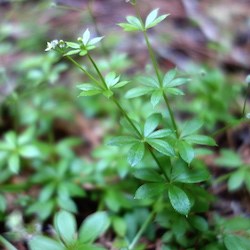
Fragrant Bedstraw
Spreading to form loose mats, this plant has stems about 20 inches (50 cm) long interspersed with whorls of six leaves. Three white-greenish flowers on short stalks branch from the leaf-worls, becoming nutlets (seeds) with hooked hairs that stick to clothes of passing hikers. The leaves release sweet-smelling coumarins when crushed, giving the plant its name.

Skunk Cabbage
Generally the first plant to bloom in spring, the bright yellow "flower" of the skunk cabbage is actually a modified bract, or leaf. The true flowers form a dense yellow-green spike that gives off a distinctive skunk-like smell. The glossy green basal leaves can grow to be up to 5 feet (1.5 m) long. Very common and easy to spot emerging from wet swampy ground throughout the park.
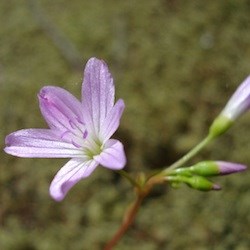
Spring Beauty
Often found growing in large patches on moist rocky outcrops or stream banks, this plant has small oval basal leaves with a few alternating leaves along a reddish-colored stem. Flowers are small, only about 0.1-0.5 inches (7-15 mm) long, and there are three to eight flowers per stem. Also known as little-leaf miner's lettuce or little-leaf montia.
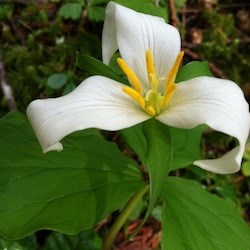
Western Trillium
This easily-recognizable and early-blooming flower features three leaves at the top of the stem framing a single flower with three large white petals. Very common throughout the park up to 5,000 feet (1,500 m).
Subalpine Flowers

Avalanche Lily
Stems are 6-16 inches (15-40 cm) long, with usually 2-3 flowers each. It takes many years for these plants to begin flowering, but they grow in abundant colonies throughout subalpine regions in the park. They are often the first to flower along the edges of melting snow. Closely related to glacier lily.
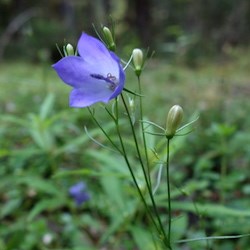
Common Harebell
Also known as Scots bluebells, this plant has a recognizable "bell"-shaped blue-purple flower. Basal leaves are round to oval in shape, while leaves along the slender stems are narrow and linear. Prefers open talus slopes, cliffs, and streambanks up to 6,500 feet (1,981 m).

Pink Mountain Heather
Forms low, branched mats with stems 4-16 inches (10-40 cm) tall and covered with alternating, needle-like evergreen leaves. Common in subalpine meadows between 5,000-8,000 feet (1,500-2,400 m).

Scarlet Paintbrush
Very common (also known as "common red paintbrush"), mostly found above 5,000 feet (1,524 m). This paintbrush stands 8-16 inches (20-40 cm) tall with lance-shaped leaves. The leaves are a good way to distinguish this paintbrush from other paintbrush species, which have lobed leaves.